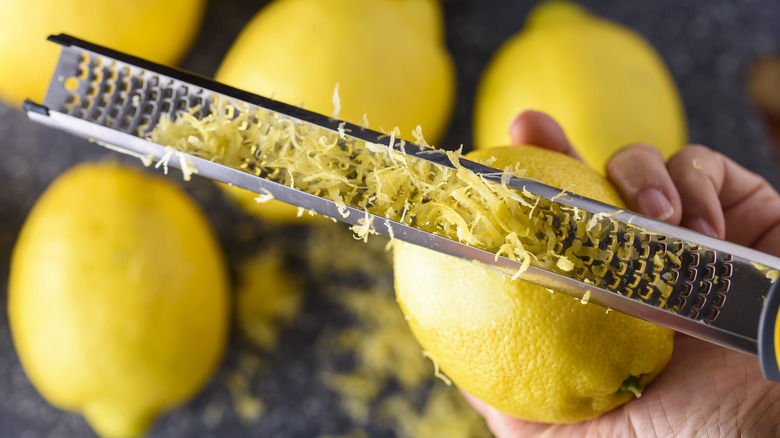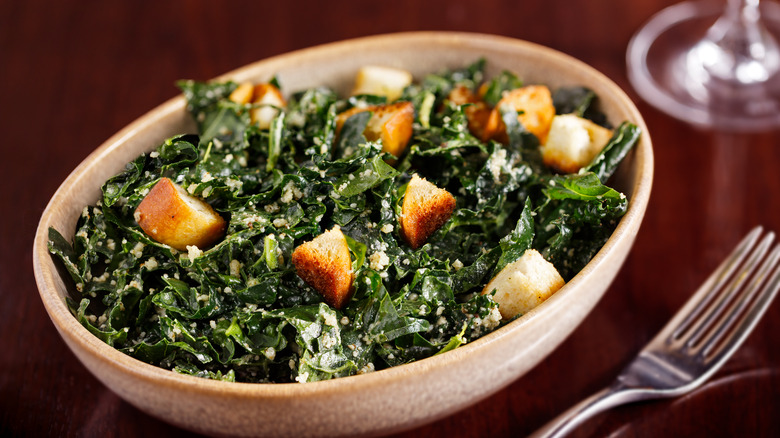Lemon Zest Will Change Your Cheesy Salads Forever
The lemon is the kitchen equivalent of the Swiss army knife: a tool that can be used for just about any purpose, from its juice to its pulp to its very rind. A natural cleanser, lemons can be used to pretty much clean your entire kitchen. But among all its uses, the lemon's primary role in the kitchen is definitely rooted in its use for food. Whether it is a delicious and refreshing lemonade or a piece of fish covered in lemon butter, the yellow citrus is an essential ingredient in many a recipe. But while we are all very familiar with the culinary benefits of lemon juice, one oft-overlooked component of the fruit is its zest, the fine yellow-colored outer layer of the fruit's peel.
The zest itself can make lemon cookies really pop, add delicate garnish to lemon bread, and the rind itself is divine when candied. A rich source of citrus aroma and oils, lemon zest is a flavorful ingredient that should see more widespread use beyond baking. One of the ways to use it is by mixing lemon zest into a salad, which brings a burst of freshness that pairs deliciously well with the saltiness of cheese. It adds a brightness that complements the creamy tang of cheese and can bring oomph to just about any dressing.
Making lemon zest dressing
To make lemon zest, you need a ripe lemon — thoroughly washed as you'll be consuming the topmost layer of its peel. Next, you can use multiple tools to extract the zest. A microplane produces a finely grated pile of zest while tools such as a zester or a channel knife produce strips. No matter which tool you use, be careful to not cut too deep, as the pith (the white layer under the zest) is bitter and unappetizing. Once the white of the pith is visible, zest another spot of the fruit.
Once you have your lemon zest, you can use it to garnish a salad that is heavy with cheese, as the bright flavors of citrus oils pair well with the saltiness of cheese — plus that bit of brightness can cut through some of the richness of dairy. For example, you can add lemon zest to homemade Caesar dressing to take your salad to a new level. In a blender, combine garlic gloves, anchovies, dijon mustard, Parmesan cheese, lemon juice, and olive oil until well incorporated. Transfer the dressing to a bowl and mix in finely grated lemon zest. Serve the dressing with a salad of shredded kale, fresh croutons, and a blizzard of grated parmesan cheese for a cheesy lemon-scented Caesar salad. The strong flavors hold up especially well against sturdy leaves like kale.
Zest everything citrus for a refreshing kick
Aside from creamy Caesar dressings, there are many other uses for lemon zest. Mixing strips of lemon zest into a citrus and herb vinaigrette is perfect for any salad, but especially ones that main course salads such as chefs' salads. Still, zest is great for many things. It can be added to any recipe that calls for a hit of lemon juice to boost the citrus flavor. For example, it's common to bake slices of lemon straight onto salmon, but grating some zest onto the fish after it's cooked adds a more lemony punch (without the risk of burning in high heat and becoming bitter). After all, while the juice is great for acidity, nothing beats out zest for flavor.
Thinking outside the lemon, however, there are even more possibilities since almost all citrus fruits can be zested, and the zest is a fantastic way to bring citrus flavors to recipes without the tartness of citrus juices. For example, dark or semi-sweet chocolate desserts can benefit from orange zest, which pairs well with the bitterness of dark chocolate. Or try a recipe of a Meyer lemon and olive oil cake where the zest of the extra-fragrant Meyer lemon is used to incorporate its aroma and flavor into the dessert.



